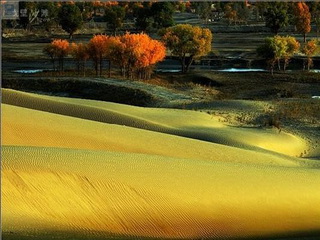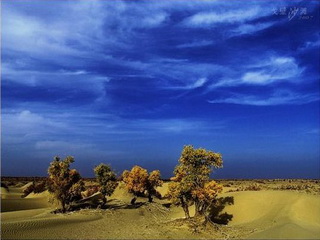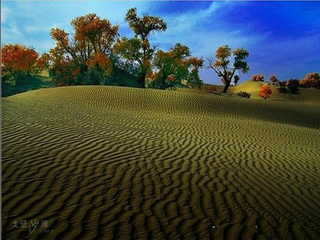search for a Trip

On October 8,1983, Xinjiang government approved the establishment of the Xinjiang Tarim Huyang Nature Reserve. This was upgraded to a national level nature reserve in February 2006.
The protected area lies in Xinjiang Bayinguolin Mongol Autonomous State's Yuli and Luntai Counties. The coordinates are E84°15'~ 85°30' ,N40°55'~ 41°15'. Its area is 39.5 million hectares. The Huyang (Poplar diversifolious) forest and its associated ecosystem is the main target of this reserve.
The location of the protected areas is part of the 53 million hectares Tarim Basin, which is the world's largest inland basin. The Reserve is bisected by the Tarim River, the world's longest inland river with a length of 2 179 km it is north of the 34 million hectares Takelimakan Desert (the world's second largest desert).
The area of the Tarim Basin Huyang forest totals 180 000 hectares, accounting for 24% of China's total Huyang forest area. It is the world’s largest original Huyang forest, with the most concentrated distribution of complete and representative areas of associated ecosystem biodiversity. The unique Huyang tree which grows in the Tarim basin had its origin in the ancient 36 states of western China, which were called "Hu". Huyang poplar also can be called Hu Tong or Wu tong.


There are more than 60 species of trees in the Huyang forests. The main associated plant vegetation is red willow and narrow-leaved oleaster. Huyang and other plants can constitute 4 main forest types: young growth Huyang forest in the River refuge, reed-red willow-Huyang forest, red willow-Huyang forest, and grass-wild hemp-Lingdangci (desert plant)-Huyang forest.
Huyang, is a species of Tertiary Period tree, which are today called living fossils. It can live and not fall for 1 000 years, and after it dies and falls, not rot for 1 000 years. Huyang is the only tall tree that lives in the desert. Huyangs rely on seeds, lateral roots, and regenerated broken branches to repopulate the species.
The Huyang tree is famous for its endurance of drought conditions, salt tolerance, resistance to blowing sand and extreme cold and survival after floods. It can resist high temperatures of 41.5 degrees, cold of-39.8 degrees, and live in harsh natural environments with rainfall between 100-289 mm and evaporation rates of 1 500-3 700 mm.
The height of an adult Huyang tree is 10 - 20 meters, with the highest reaching 28 meters. The tree-crown can reach 20 meters. Since the growth rings of its branches gradually thicken, some branches can grow up to half meter in circumference, although the young branch resembles a toothpick. Its bark is cracked and has a gray color.
The appearance is obvious during the four seasons of the year. The bud whip is green in spring and the leaves are green also in summer, but the leaves turn golden in autumn, and then, when winter is approaching, become dark yellow. The leaves of the Huyang are diversiform, meaning they have 2 or 3 shapes. Huyang also secrete a kind of resin, named "Huyang Tears", which has multiple uses after drying.
Related Tours:
China Attractions Guide
- Anhui Attractions
- Beijing Attractions
- Chongqing Attractions
- Fujian Attractions
- Gansu Attractions
- Guangdong Attractions
- Guangxi Attractions
- Guizhou Attractions
- Hainan Attractions
- Henan Attractions
- Hongkong Attractions
- Hubei Attractions
- Hunan Attractions
- Inner Mongolia Attractions
- Jiangsu Attractions
- Jiangxi Attractions
- Manchuria Attractions
- Ningxia Attractions
- Qinghai Attractions
- Shaanxi Attractions


